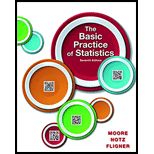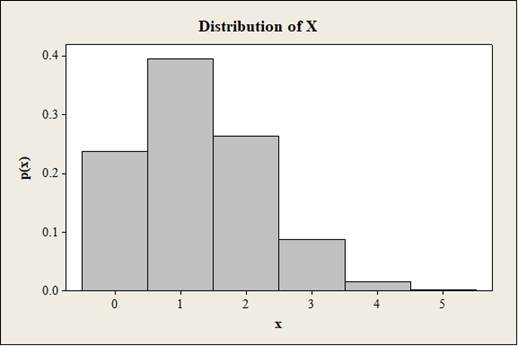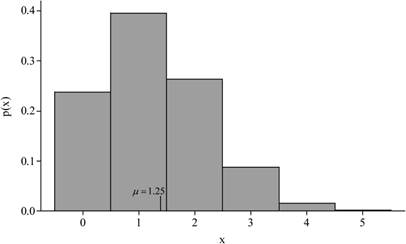
(a)
To find: The values of n and p, X has a binomial distribution.
(a)
Answer to Problem 14.25E
The value of n and p, if X has a binomial distribution is 5 and 0.25, respectively.
Explanation of Solution
Given info:
Yosemite National park has arranged the 5 high sierra camps
Justification;
Define the random variable X “the number of years that have been selected to hike the loop.
Also, there are two possible outcomes (groups that hike the loop and do not hike the loop) and the
Therefore, the number of years that have been selected to hike the loop follows the binomial distribution with
Thus, the value of n and p, if X has a binomial distribution is 5 and 0.25, respectively.
(b)
To find: The possible values that X takes.
(b)
Answer to Problem 14.25E
The possible values that the random variable X take are 0, 1, 2, 3, 4 and 5.
Explanation of Solution
Since, the national park has arranged only the 5 high sierra camps, the possible values that (X) the number of years that have been selected to hike the loop takes are 0, 1, 2, 3, 4 and 5.
(c)
To find: The probability value for
To find: The probability value for
To find: The probability value for
To find: The probability value for
To find: The probability value for
To find: The probability value for
To obtain: The probability histogram for the distribution of X
(c)
Answer to Problem 14.25E
The probability value with
The probability value with
The probability value with
The probability value with
The probability value with
The probability value with
The probability histogram for the distribution of X is given below:

Explanation of Solution
Given info:
The probability value with
The binomial distribution formula is,
Substitute
Thus, the probability value with
The probability value with
The binomial distribution formula is,
Substitute
Thus, the probability value with
The probability value with
The binomial distribution formula is,
Substitute
Thus, the probability value with
The probability value with
The binomial distribution formula is,
Substitute
Thus, the probability value with
The probability value with
The binomial distribution formula is,
Substitute
Thus, the probability value with
The probability value with
The binomial distribution formula is,
Substitute
Thus, the probability value with
Software procedure:
Step-by-step procedure to obtain the probability histogram for the distribution of X is:
- Choose Graph > Bar Chart.
- From Bars represent, choose Values from a table.
- Under One column of values, choose Simple. Click OK.
- In Graph variables, enter the column of X as
- In Row labels, enter the column of P(X)
- Click OK.
Justification:
In the probability histogram, the values of X are taken along the horizontal axis, the probability values along the vertical axis, and the corresponding probability is represented by the height of the bars.
(d)
To find: The mean and the standard deviation of the distribution.
(d)
Answer to Problem 14.25E
The mean and the standard deviation of the distribution is 1.25 years and 0.9682 years.
Explanation of Solution
Calculation:
Mean:
The mean is calculated by using the formula:
Substitute n as 5 and p as 0.25.
Thus, the mean of distribution is 1.25 years.
Standard deviation:
The standard deviation is calculated by using the formula:
Substitute n as 5, p as 0.25 and q as
Thus, the standard deviation of distribution is 1.2962 years.
From the part (c), by using the probability histogram for the distribution of X, the location of mean with 1.25 is marked on the histogram as follows:

Want to see more full solutions like this?
Chapter 14 Solutions
BASIC PRAC OF STATISTICS+LAUNCHPAD+REE
- For a binary asymmetric channel with Py|X(0|1) = 0.1 and Py|X(1|0) = 0.2; PX(0) = 0.4 isthe probability of a bit of “0” being transmitted. X is the transmitted digit, and Y is the received digit.a. Find the values of Py(0) and Py(1).b. What is the probability that only 0s will be received for a sequence of 10 digits transmitted?c. What is the probability that 8 1s and 2 0s will be received for the same sequence of 10 digits?d. What is the probability that at least 5 0s will be received for the same sequence of 10 digits?arrow_forwardV2 360 Step down + I₁ = I2 10KVA 120V 10KVA 1₂ = 360-120 or 2nd Ratio's V₂ m 120 Ratio= 360 √2 H I2 I, + I2 120arrow_forwardQ2. [20 points] An amplitude X of a Gaussian signal x(t) has a mean value of 2 and an RMS value of √(10), i.e. square root of 10. Determine the PDF of x(t).arrow_forward
- In a network with 12 links, one of the links has failed. The failed link is randomlylocated. An electrical engineer tests the links one by one until the failed link is found.a. What is the probability that the engineer will find the failed link in the first test?b. What is the probability that the engineer will find the failed link in five tests?Note: You should assume that for Part b, the five tests are done consecutively.arrow_forwardProblem 3. Pricing a multi-stock option the Margrabe formula The purpose of this problem is to price a swap option in a 2-stock model, similarly as what we did in the example in the lectures. We consider a two-dimensional Brownian motion given by W₁ = (W(¹), W(2)) on a probability space (Q, F,P). Two stock prices are modeled by the following equations: dX = dY₁ = X₁ (rdt+ rdt+0₁dW!) (²)), Y₁ (rdt+dW+0zdW!"), with Xo xo and Yo =yo. This corresponds to the multi-stock model studied in class, but with notation (X+, Y₁) instead of (S(1), S(2)). Given the model above, the measure P is already the risk-neutral measure (Both stocks have rate of return r). We write σ = 0₁+0%. We consider a swap option, which gives you the right, at time T, to exchange one share of X for one share of Y. That is, the option has payoff F=(Yr-XT). (a) We first assume that r = 0 (for questions (a)-(f)). Write an explicit expression for the process Xt. Reminder before proceeding to question (b): Girsanov's theorem…arrow_forwardProblem 1. Multi-stock model We consider a 2-stock model similar to the one studied in class. Namely, we consider = S(1) S(2) = S(¹) exp (σ1B(1) + (M1 - 0/1 ) S(²) exp (02B(2) + (H₂- M2 where (B(¹) ) +20 and (B(2) ) +≥o are two Brownian motions, with t≥0 Cov (B(¹), B(2)) = p min{t, s}. " The purpose of this problem is to prove that there indeed exists a 2-dimensional Brownian motion (W+)+20 (W(1), W(2))+20 such that = S(1) S(2) = = S(¹) exp (011W(¹) + (μ₁ - 01/1) t) 롱) S(²) exp (021W (1) + 022W(2) + (112 - 03/01/12) t). where σ11, 21, 22 are constants to be determined (as functions of σ1, σ2, p). Hint: The constants will follow the formulas developed in the lectures. (a) To show existence of (Ŵ+), first write the expression for both W. (¹) and W (2) functions of (B(1), B(²)). as (b) Using the formulas obtained in (a), show that the process (WA) is actually a 2- dimensional standard Brownian motion (i.e. show that each component is normal, with mean 0, variance t, and that their…arrow_forward
- The scores of 8 students on the midterm exam and final exam were as follows. Student Midterm Final Anderson 98 89 Bailey 88 74 Cruz 87 97 DeSana 85 79 Erickson 85 94 Francis 83 71 Gray 74 98 Harris 70 91 Find the value of the (Spearman's) rank correlation coefficient test statistic that would be used to test the claim of no correlation between midterm score and final exam score. Round your answer to 3 places after the decimal point, if necessary. Test statistic: rs =arrow_forwardBusiness discussarrow_forwardBusiness discussarrow_forward
 MATLAB: An Introduction with ApplicationsStatisticsISBN:9781119256830Author:Amos GilatPublisher:John Wiley & Sons Inc
MATLAB: An Introduction with ApplicationsStatisticsISBN:9781119256830Author:Amos GilatPublisher:John Wiley & Sons Inc Probability and Statistics for Engineering and th...StatisticsISBN:9781305251809Author:Jay L. DevorePublisher:Cengage Learning
Probability and Statistics for Engineering and th...StatisticsISBN:9781305251809Author:Jay L. DevorePublisher:Cengage Learning Statistics for The Behavioral Sciences (MindTap C...StatisticsISBN:9781305504912Author:Frederick J Gravetter, Larry B. WallnauPublisher:Cengage Learning
Statistics for The Behavioral Sciences (MindTap C...StatisticsISBN:9781305504912Author:Frederick J Gravetter, Larry B. WallnauPublisher:Cengage Learning Elementary Statistics: Picturing the World (7th E...StatisticsISBN:9780134683416Author:Ron Larson, Betsy FarberPublisher:PEARSON
Elementary Statistics: Picturing the World (7th E...StatisticsISBN:9780134683416Author:Ron Larson, Betsy FarberPublisher:PEARSON The Basic Practice of StatisticsStatisticsISBN:9781319042578Author:David S. Moore, William I. Notz, Michael A. FlignerPublisher:W. H. Freeman
The Basic Practice of StatisticsStatisticsISBN:9781319042578Author:David S. Moore, William I. Notz, Michael A. FlignerPublisher:W. H. Freeman Introduction to the Practice of StatisticsStatisticsISBN:9781319013387Author:David S. Moore, George P. McCabe, Bruce A. CraigPublisher:W. H. Freeman
Introduction to the Practice of StatisticsStatisticsISBN:9781319013387Author:David S. Moore, George P. McCabe, Bruce A. CraigPublisher:W. H. Freeman





